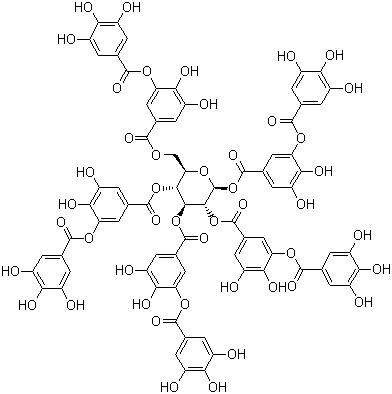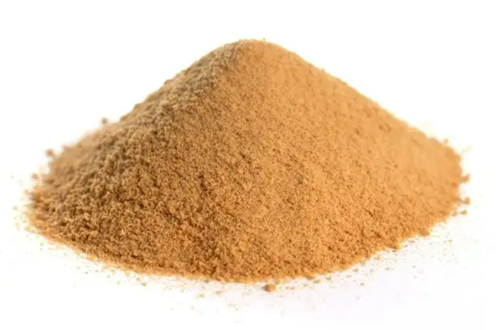Why is tannin preferred for feed additive?
Tannin, also known as tannic and tannic acid, is an important secondary metabolic product of plants. Besides lignin, tannin is one of the most abundant plants phenolic compounds, widely existing in the leaves, shells, flesh and bark of plants. Tannins in plants are stored in an organelle derived from chloroplasts. They are enclosed in cellular fluid and do not interact with proteins and other nutrients, so they do not interfere with plant metabolism. In the past, tannin was limited to the “anti-nutrient factor” in feed. In recent years, it has been found that tannin has a special astringent and anti-diarrhea effect on the intestinal tract of animals, which can inhibit pathogenic microorganisms and enhance the antioxidant, antiviral and anti-cancer capabilities of animals. Tannins are currently approved by the US Food and Drug Administration (FDA) as a food additive added to beverages and meat products. Tannin was approved by the European Union as a new feed additive for use in some livestock and poultry in 2016. A large number of experiments have proved that tannic acid added to feed can effectively promote animal growth, antibacterial and antibacterial, improve intestinal microecological environment, prevent diarrhea of piglets and so on.
Classification of tannins
The multiple phenolic hydroxyl groups of tannin can combine with polysaccharides, alkaloids, proteins and metal ions to undergo complexation or electrostatic reaction, thus changing their physical and chemical properties. According to their chemical properties, mono-rather can be divided into hydrolyzed tannins, condensed tannins and complex tannins.
Hydrolyzed tannin mainly exists in the bark and fruit of Chinese chinagood, pomegranate, cotinus, witch hazel and other plants, the relative molecular weight of 500~3000, composed of gallic acid or sugar-based tannic acid and its derivatives. Tannic acid is an important hydrolyzed tannic acid, also known as tannic acid, chemical formula C76H52O46, structure is shown below, it is a slightly smelly, bitter yellow or light brown light crystalline powder, soluble in glycerol, water and ethanol, can be hydrolyzed into gallic acid, glucose.
Condensed tannin is a polymer composed of flavane-3-alcohol (catechin) as a unit. It is mainly found in Onobrychis viciifolia, Herbaceous roots, grape skins and seeds. Its relative molecular weight is 1900~28000, also known as preanthocyanin and polyflavanols. Condensed tannic acid has a strong anti-nutrient absorption effect and is defined as an anti-nutrient factor in feed. A large number of studies have shown that tannic acid has strong antibacterial, bactericidal, anti-oxidation, convergence and improve the performance of animal production, and can be used as an additive in animal nutrition.
Pharmacological effects of tannin in feed addition
Intestinal astringent effect
After entering the digestive tract of animals, tannin combines with the proteins or some digestive enzymes on the surface of gastrointestinal mucosa, reducing the digestion and absorption of nutrients in the intestine, so tannin has anti-nutritional activity. Tannin forms a protective film on the intestinal mucosal surface by coagulating proteins, thus promoting the local intestinal tract to achieve anti-inflammatory, hemostatic and reduced exudation. Tannin and intestinal mucosal proteins through hydrophobic bond and hydrogen bond polymerization reaction, produce intestinal convergence effect, and reduce the stimulation of intestinal peristalsis, slow down the passage of chyme in the intestine, promote intestinal water to be fully absorbed, and then relieve diarrhea.
Tannic acid can slow down intestinal peristalsis, slow down the movement of chyme in the intestine, so that water and nutrients can be better digested and absorbed, thus reducing the occurrence of diarrhea of weaned piglets. In one experiment, weaned piglets at 22 days of age were fed 0.07% plant extract with tannic acid as the main component (80% content) and compared with 0.04% 15% aureomycin. The results showed that the diarrhea rate of piglets in tannic acid group was decreased by 30.4% (p < 0.05) compared with that in aureomycin group. Therefore, the anti-diarrhea effect of plant extract supplemented with tannic acid was better than that of aureomycin.
Anti-bacterial, anti-parasitic, anti-viral
Tannins form precipitates by binding to membrane proteins, polysaccharides and phospholipids of pathogens, and interfere with the absorption of nutrients by bacteria. Tannic acid also weakens the shielding of drugs by destroying cell wall structure and changing the permeability of cell membrane, and then inactivates them by forming hydrogen bonds with bacterial enzymes and toxic proteins, thus inhibiting most bacteria, parasites and fungi.
One experiment found that tannic acid had a significantly better inhibitory effect on gram-positive bacteria than gram-negative bacteria, and the minimum inhibitory concentration (MIC) of tannic acid against Micrococcus gargaris, Staphylococcus aureus and Bacillus subtilis were 0.19mg/mL, 0.39 mg/mL and 0.39 mg/mL, respectively. The MIC of potassium sorbate against all three bacteria was greater than 6.25mg/mL. In addition, tannic acid has better inhibition effect on Escherichia coli, Pseudomonas aeruginosa and Penicillium, which is better than potassium sorbate. In addition, tannic acid can inhibit the formation of all kinds of bacterial biofilm, and can significantly reduce the number of bacterial biofilm formation at 0.08mg/mL (p < 0.05), thus exerting antibacterial and bacteriostatic effect. Suggests tannins have the potential to treat “superbug” infections.
Antioxidants
Tannic acid has strong antioxidant activity in vitro. The hydrogen released by its abundant o-hydroxyl group can reduce Fe3+, clear free radicals (ROS, DPPH, OH·, HO2·, NO·), block the chain reaction and inhibit lipid peroxidation, thus showing strong antioxidant capacity. Vitro antioxidant tests showed that tannin had better scavenging effect on DPPH free radical than ascorbic acid, and could improve the activity of antioxidant enzymes and reduce the level of oxidative stress in vivo.
They support gut health and performance in poultry, and are effective antioxidants. They can scavenge free radicals in the gut, which can damage intestinal cell membranes and increase oxidative stress and inflammation. Antioxidant test in vitro showed that the DPPH clearance rate of 0.01mg/mL tannic acid was 92.13%, which was better than that of ascorbic acid at the same concentration. The removal rate of OH by 1.0mg/mL pure tannic acid was 65.58%. The IC50 value of tannic acid was 2.10μg/mL. The results showed that with the increase of tannic acid supplemental level in the diet of finishing pigs, the serum creatine kinase (CK) content was decreased, the T-SOD content was gradually increased, and the MDA content was significantly lower than that of the control group. The serum CK content in the 0.045% tannic acid group was significantly decreased compared with the control group (p < 0.05), the T-SOD content was increased (p < 0.05), and the MDA content was decreased (p < 0.05), indicating that tannic acid can effectively scour oxygen free radicals in the body and improve the activity of antioxidant enzymes. Reduces oxidative stress levels in the body.
Improve intestinal environment
Tannin can relieve intestinal inflammation, improve intestinal mucosal morphology and regulate intestinal microecological. It combines with proteins to form tannin protein, which decomposes and releases tannin in the alkaline environment of the small intestine, thus coagulating proteins on the inflammatory surface of the intestinal mucosa and reducing inflammatory exudates, thus playing a role in alleviating intestinal inflammation. It has also been reported that tannin can up-regulate the synthesis of proteins involved in oxidative stress defense and cell wall biotransformation in lactic acid bacteria, prolifize beneficial bacteria (lactic acid bacteria, bifidobacteria, etc.) and adapt to animal intestines. This suggests that tannin can be used to regulate the intestinal flora of livestock and poultry to promote intestinal immune regulation and intestinal health.
A certain amount of tannic acid added to feed can improve the area of nutrients absorbed by the small intestine and the digestive enzyme activity in the small intestine, which is conducive to the absorption of nutrients by animals. The experimental results show that adding 1000mg/kg tannic acid to the diet of weaned piglets can improve the activity of digestive enzymes. Compared with the control group without tannic acid, the activity of gastric egg white enzyme was increased by 37.51% (p < 0.05), the activity of amylase was increased by 44.03% (p < 0.05) and lipase was increased by 34.45% (p < 0.05) in the 0.1% tannic acid group. Adding 0.05%, 0.1%, 0.15% and 0.2% tannic acid in broilers’ basal diet can increase the number of bifidobacteria and Lactobacillus in cecum of broilers and inhibit the growth of Escherichia coli.
Improve nutrient digestibility
Researchers are now studying the benefits of using tannins in animal feed to increase productivity and milk yields. The results showed that adding appropriate tannic acid could significantly improve the performance of broilers in the later stage, and the optimal supplemental level was 1.5kg/t. Compared with the control group, at 42 days of age, the average body weight of broilers in the 0.15% tannic acid group was increased by 10.65% (p < 0.05), feed intake was increased by 14.39% (p < 0.05), and meat feed ratio was decreased by 13.74% (p < 0.05).
In short, tannin is generally considered safe for use in animal feeds. It is also environmentally friendly, which makes it an excellent additive for the feed industry. Other benefits of tannins for livestock include improving animal health by promoting the assimilation of proteins and improving animal defenses. They believe the antioxidants in tannins can help the rumen fend off pathogens and protect the plant’s protein. In addition, tannins reduce methane emissions in the animal’s stomach. This can be done by inhibiting the activity of microbial enzymes and microorganisms that break down cellulose. This is a big benefit for livestock and for the environment.




